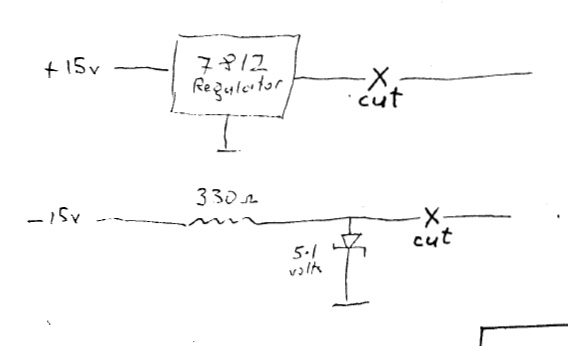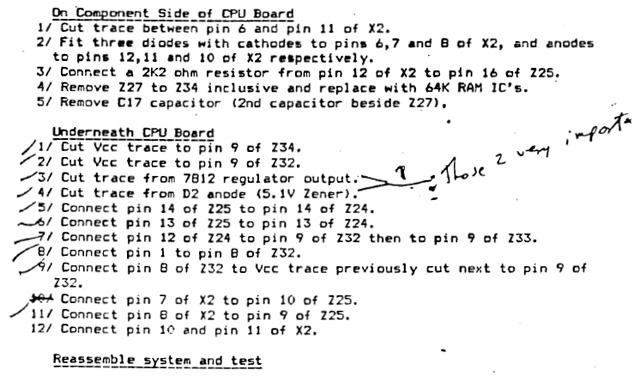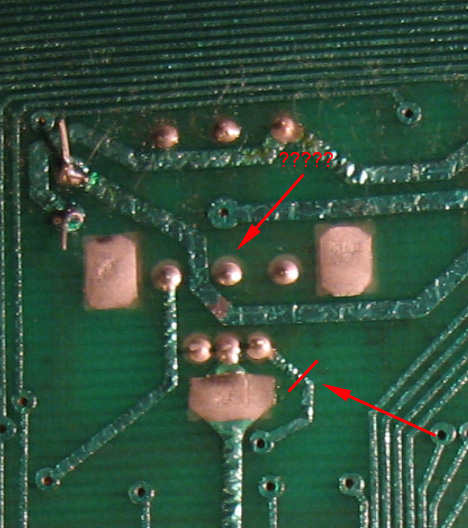System 80 memory expansion gone wrong
Introduction
Anyone following my blog articles would have noticed that I usually write an entry after I've completed a successful project. Most projects I've tackled do have a positive outcome eventually but not all. This latest project involved smoke, not from an old capacitor but from something I did wrong.
Why bother writing about an embarrassing blunder? Well, I figure making mistakes is always a lesson. You learn from it. Luckily this mistake was on a junk board which had no value. Having erred here, hopefully I won't repeat it when it's more critical.
What I was trying to achieve
In the past weeks I've been restoring an old Dick Smith System 80. I've cleaned it up, repaired bits and pieces and added some of the common modifications. It's now a nice-looking machine. However it is only 16k and as a final step I wanted to modify it to 48k.
A 48k upgrade can be done several ways. I elected to try using 4164 DRAM chips rather than the more common 4116 chip-stacking, as was practiced in the day. Step-by-step instructions for this process can be found in a document produced by John Gilbert Ltd., a firm who specialised in System 80 upgrades in the early 1980s.
A trial run
I'm not a skilled 8-bit hardware techie and I was using instructions whose accuracy I couldn't verify. For safety therefore, I decided to carry out the modification on an old "junk" System 80 CPU board I had lying around. The board was worse for wear and didn't actually work. The idea was to bring it back to life, then use this board to trial the method. If it worked, I'd then apply the modification to the "good" CPU board in the 16k machine.
After some help from the EACA discussion forum I managed to get the board back into working order (a faulty ROM was the issue) using standard 16k 4116 ICs. I then applied the modification, carefully working through the steps in the John Gilbert document.
Result
Switching back on after reassembling looked promising...sort of. A memory check showed the machine now had 48k, but some things were a little odd. Firstly, the screen moved up and down a bit when the machine was first turned on. It stopped after it had warmed up. Second, when the machine was cold a "D" was sometimes displayed after READY? at boot. It didn't seem to do this after the machine had warmed up.
Initial diagnosis
At first I thought maybe a video RAM issue?. But then I started to suspect something to do with power. System 80/Video Genie guru Knut Roll-lund suggested this possibility also. However, I was sure the PSU was ok, as with the 16K CPU board in the display was rock solid and there was no sign of a problem. It had something to do with the 64k upgrade modification.
I examined the board again especially around the 7812 regulator. I noticed this regulator was very hot. I checked the John Gilbert guide again. It contained the following steps...
3. Cut trace from 7812 regulator output (I'd done that!)
4. Cut trace from D2 anode (5,1v Zener) (I'd done that. Actually I just pulled the anode end of the diode out of the board)
Hmm...Then I looked at the document a bit more carefully. As well as steps they had a hand sketched circuit diagram as to what to cut. Regarding the anode of the D2 diode the diagram seemed to indicate that I'd made the break at the wrong place? The anode part of the diode still needed to be connected to the 330u resistor. It was the long trace downstream from that which needed to be cut.

Figure 1. Part of the hand-drawn schematic showing where to cut around the 7812 regulator
I reattached the diode, cut what I thought was the right track, reassembled then switched on.

Figure 2. Red lines show where tracks were cut
The screen showed nothing. The wisps of smoke started to appear from somewhere. I’m not actually sure WHERE exactly but I think it was the regulator. I switched off.
Oh dear… What went wrong.
Probable cause
I carefully went over the instructions again to see if I’d missed anything. It was then I had a “Duh!” moment. The John Gilbert steps are written in sections (figure 3.). I suddenly noticed the tracks I was suppose to cut WERE ON THE BOTTOM OF THE BOARD NOT THE TOP!

Figure 3. John Gilbert 48k upgrade steps. Handwritten section is not mine
So. I was not suppose to cut any tracks on top of the board around the 7812. My feeling was that this was probably why it blew up!
I flipped the board over, and saw that there indeed was a track underneath the output pin of the regulator (Figure 4).

Figure 4. Track that should have been cut. Where is the trace from D4 though?
I cut the track, bridged the output track which I'd cut above and switched on the machine. No response. I figured I now had a cooked component somewhere.
A mystery?
One thing still puzzled me. Step 4 in the "Underneath CPU Board" says to cut the trace from D2 anode. What trace? There is no trace from the D2 anode on the underside of the board as indicated by the red ?? arrow in figure 4? Could the instructions have been mistaken here? There is a trace ABOVE the board, and this seems to correspond to the hand written schematics in Figure 1.
Reflections
I still need to figure out what went wrong here. To do that I really need to sit down and study (and understand) in detail just what is going on around this power regulator.

Figure 5. System 80 power regulation
Obviously lifting the diode initially and cutting the regulator output on the top part of the board were mistakes. It's probably amazing the thing worked at all. But I don't yet understand what made things blow up when I reinserted the D4 anode and cut the track from the diode and resistor? The reason I don't know is because I don't really understand how the power regulator works and how it relates to the rest of the system. It's probably obvious to someone who does.
The lesson here is...
- Take your time and read everything
- If you don't REALLY understand what's going on and are just following a recipe, try your mod on a spare board first. If it turns to custard, you haven't lost anything valuable and have probably learnt something in the process. Alternatively, try to understand the full implications of any alterations to the circuit board first so you can ascertain if the instructions make sense.
Tez
27th July, 2010
| Tweet |